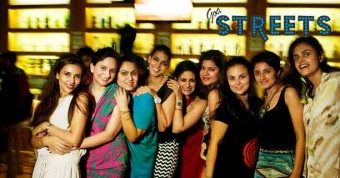Sarmishtha Ray with her painting which will be one of the star attractions at her upcoming exhibition at Kala Academy
The Creative, ambulance Bohemian and Path Breaking People Who Make Goa Their Home
Many don’t know this, but Orhan Pamuk, winner of the Nobel Prize for Literature in 2006, for many years made Goa his part-time home, in a village in Salcete. As does another globally famous author, Amitav Ghosh, who lives in Aldona. Not to mention Pamuk’s one-time partner, Kiran Desai, winner of the 2006 Man Booker Prize, who also spends lots of time in the state. As do hundreds of other creative minds, drawing inspiration from the Goan countryside, the rustle of leaves being blown away by the winds, the sing-song melodies of wandering birds.
It’s not just writers, though, who find Goa inspiring. Top Indian fashion designer Malini Ramani also spends much of her time – when she’s not jet-setting around the world – in Goa. She’s now shifted home from the hustle and bustle of Candolim, to the more serene environs of Siolim. Her equally famous mother, socialite Bina Ramani, also calls Goa home for half the year.
There are dozens of others who may not be famous faces in the media, but who are making a big splash with their noteworthy, creative projects in Goa. Some are local and some are foreign. What they have in common is that they form part of what can be called a parallel universe in Goa – an alternative scene consisting of artists, entrepreneurs, writers, performers and Bohemians of every stripe. It can be said that the scene’s epicenter remains largely in and around Anjuna, though the crowd is dispersed throughout North and South Goa.
Let’s hear what some of these denizens of Goa’s parallel universe have to say.
Kees Van Andel and Karen Peace
Kees Van Andel and Karen Peace have made themselves at home in an old Goan-Portuguese house in Assagao, where they have a high-end jewellery boutique called Cheshire Cat that attracts clientele from all over the world – by word of mouth. The peaceful environment in Goa, they say, is very conducive for creativity. “We wanted the peace and quiet,” says Karen. “Somebody sees our jewellery being worn by somebody in Delhi or Moscow, and they ask them where they got it from. And when they come to Goa they come straight here,” she says.
There are three goldsmith artisans working for them during the season, and they have also trained five young women from in and around Assagao to make beaded jewellery. Their clothing line is called Pink India, and the Cheshire Cat gallery also has paintings and other designer items.
The thing they like about Goa, they say, is “The peacefulness. Everybody knows each other. The locals are very friendly, very nice, very open. We felt very welcome when we first bought this house. They treat you like normal people, not like a tourist.” While she’s from north Ireland, he’s from Holland.

Karen Peace and Kees Van Andel, owners of Cheshire Cat at Assagao
Sarmishtha Ray
Sarmishtha Ray is one of India’s top artists, with her paintings adorning the prime minister’s house In New Delhi and private collections around the world. While she spent most of the ‘90’s in Baga and Calangute, painting and helping her partner run a restaurant, she now lives along the quiet riverside in Candolim.
She has a different take on what it means to be ‘alternative’ in Goa. “Yes,” she says when asked whether she considers herself to be part of the alternative scene here, “Because I am not a Goan and I was brought up in Bombay. I don’t speak Konkani either. I would say that people like me contribute to a cosmopolitan Goan culture. It is an alternative to the local culture and customs. The good thing about Goa is that it has absorbed people of all cultures peacefully and harmoniously. Being ‘alternative’ would mean that I carry on living an urban existence in a semi-rural set-up like Goa. It is a lifestyle.”
Elaborating, she says, “The mixture of different cultures in Goa has produced a vibrant and colourful culture. Yes, there is a downside – a certain amount of hedonism and self-indulgence has crept in. There is a lot of selfishness and greed. But this belt – Candolim to Arambol – also supports many talented musicians, painters, fashion designers and writers – some of whom have made it big globally. Food is also quite exciting in its diversity and there are many different cuisines and a lot of choice. Like, I said before, it’s colourful.”
Unfortunately, Sarmishtha has suffered some setbacks of late, including being robbed and undergoing some health difficulties. Yet she betrays little bitterness.
Yahel Chirinian
Yahel Chirinian, an acclaimed installation artist who lives in Arpora, loves Goa because she doesn’t have to be part of any scene. Goa, she says, allows you to live in your own bubble. Just being here is an artistic experience, she adds, because you become part of the beautiful landscape.
“Most people see India in terms of its rich and influential history, its Gods and devotion, Bollywood movies, or its awakening as an economic giant. However, there is so much more about the complex and dynamic India of today. The depth of this country, the contradictions of its society, the dreams and hopes of its people, and its energy and passion toward the future.”
“I am interested in those ideas that extend us out and change the reality of the sense of territory that we as humans have,” says the French-born Yahel who has studied Sanskrit in Varanasi and architecture in Paris, Rome and Tokyo.
Says she of her approach, “I came to the installation works wanting to bring the light of day into a landscape. I did not want to make a mark on the surface of the earth. I wanted to employ sunlight, moonlight and starlight to empower a work of art. Instead of competing with the sunset, I wanted to use it, to take it in.”
Fortunately for Yahel and all the other creative souls who have flocked here, it’s hard to beat Goa for inspirational sunsets.




